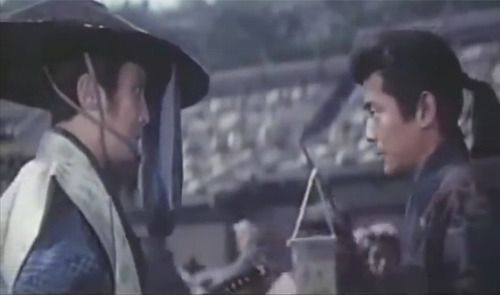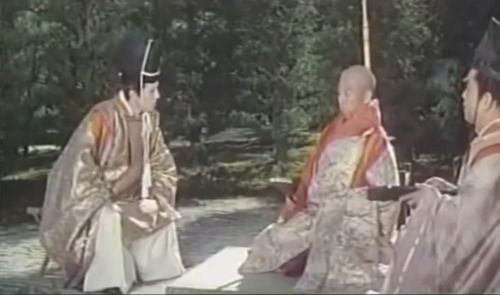--Sorry for the recent lack of updates, guys! For this post I decided to
resume the talk about those unexpected allies that Nobunaga got to gather around himself in peculiar times of his life, expecially those that can be considered as his mortal enemies and focus their "good name" on it.
The first "misfit" of this historical adventure is the figure of the "pirate".
Not so different from the image of the Western
corsair, Japanese pirates were pretty much warriors who preferred to attack from the coast, usually profiting of the convenient opening on the sea of their hometowns.
Talking about "pirates" is then just an improper way of talking about naval forces, and when talking about a powerful navy, the reference by default is one of the arch-enemy of Nobunaga, the
Mouri clan of
Aki.
The Mouri became the impressive powerhouse that they were because of their massive naval force. Its bulk was composed by the
Murakami clan, that in 1576 contributed to the defeat of the Oda during the first
Battle of Kizukawaguchi.
Another famous "pirate" who gave Nobunaga some headaches was
Ohama Kagetaka, seated in
Shima Province, allied with both the Takeda and the Uesugi and related to the
Kitabake clan of Ise, the very clan that Nobunaga bent to his will on 1569, imposing Nobukatsu as its adopted son-- From these premises you may feel that pirates were pretty much Nobunaga's enemy, expecially if you consider the design on certain videogames when it comes to the Mouri clan.
In reality, Nobunaga could boast some resourceful "pirate ally" in the figure of
Kuki Yoshitaka too.
Yoshitaka allied with Nobunaga on 1574, providing naval support during the
Siege of Nagashima, where Nobunaga could finally defeat the last rebels of his very own Owari province.
He gave his support again on the above mentioned first
Battle of Kizukawaguchi, where the Murakami defeated his fleet by using lighted arrows to set the ships on fire. It's from this defeat and the unreasonable request of Nobunaga to come up with a ship that could resist fire attacks that Yoshitaka is usually credited with the invention of the "iron ships" (
tekkousen), ships constructed on an unflammable iron structure that would later develop in the
atakebune of the
Invasion of Korea, which were covered in metal plates.

Thanks to this intuition, the fleet of Yoshitaka would defeat the naval force of the Mouri, giving a huge blow to the resistance of the
Ishiyama Honganji.
Speaking of Nagashima and the Ishiyama Honganji, we enter the second "misfits" of this peculiar circle of allies of Nobunaga, the infamous
Ikko Ikki.
Literally,
ikko ikki means "One Opposition, One Riot" and were sort of "confederates" composed of warrior monks, commoners and
ji-samurai, all grouped together to protect their interests and independence from the strong powers of the
daimyo. From Nobunaga's perspective, just "rebels" and a huge pain in the ass.
He spent 4 years to defeat the Ikko Ikki of Nagashima, and over 10 when it came to the Ishiyama Honganji.
Beside them, another terrible bother for Nobunaga were the Ikko Ikki from
Saika, the so-called
Saika Ikki, allies of the Ishiyama Honganji and the Mouri; the Saika Ikki were quite bothering expecially because they were leaders when it came to the use of firearms.
Their leader was the famous
Saika Magoichi, another arch-enemy of Nobunaga, a character surrounded by so much mystery to paint him almost as some kind of
ninja in some variations of the story.
Ironically, one of first Ikko Ikki to collaborate with Nobunaga starting 1577 would come exactly from that oh-so-incorruptible Saika team.

To get the idea, we have to understand how the Saika Ikko was organized: located in
Ota, the area, developed around the
Kinokawa river and influenced by the
Negoro-ji, was composed of five different groups, roughly based around five castles of the area. This organization was called the
Saika Gorakami (雑賀五緘衆), the "Five Linkage of Saika".
Saika Magoichi was the leader of one of them, the
Jikkago (十ヶ郷), and his rival, a certain
Tsuchibashi Heiji, was the leader of
Saika-no-Sho (雑賀荘).
The other three groups, shockingly, on 1577, decided to join Nobunaga's cause, providing help to invade the area.
Ota Gyuichi in his
Shinchokoki reports that thanks to them
"acting as their guides in the mountains, Sakuma Uemon, Hashiba Chikuzen, Araki Settsu-no-kami, Bessho Kosaburo, Bessho Magoemon and Hori Kyuutaro struck deep into Saika and visited even the remote borderlands of the territory with fire and destruction".
On the same year,
"fearing the devastation of the entire province", seven leaders of the Saika Ikki, included Magoichi and Heiji, surrended to Nobunaga, who pardoned them, pacificating the area.
This story is usually omitted when it comes to Saika Magoichi, everywhere portrayed as the epitome of freedom and rebellion against a devilish Nobunaga.
Another story that you'd rarely hear is how Magoichi asked for Nobunaga's help against Heiji on 1582 to eradicate his influence over the area: the leader of the Tsuchibashi clan was thus erased, and his son, part of the Negoro-ji, was forced to diminish his power within the organization.
We mentioned the
Negoro-ji a few times already, so you may have guessed from where the third "misfits", the
Warrior Monks (
souhei, 僧兵) who supported Nobunaga, came.
In fact, when the "Three Linkage of Saika" decided to give their support to Nobunaga on 1577, even a certain
Sugi-no-bo from Negoro-ji (根来寺の杉の坊) was there.
But, again, let's go in order.
The Negoro-ji was another Buddhist temple filled with fierce and proud Warrior Monks, who just like their laic counterpart were quite skilled with firearms, expecially when it came to guns of Tanegashima manifacture.
The "leader" of this revolution is to find in the figure of
Tsuda Kenmotsu (Sanchou), who on 1543 went to
Tanegashima himself to learn about the new weapon imported by the Westerners; he would develop the
Tsuda-ryu school of gunnery, which secrets would be inherited by his second son,
Tsuda Shozan, together with the leadership of the above mentioned
Sugi-no-bo which is nothing else but a rectory within the precints of the Negoro-ji.
Warrior Monks from there would follow the Ikko Ikki to support Nobunaga's men in their raids. This kind of behaviour is not to judge too harshly, in fact both Ikko Ikki and Warrior Monks, expecially when so specialized in warfare, would easily act as mercenaries if required and profitable.
It's ironic to see the son allying with his father's arch-enemy, but it must be noted that Negoro-ji never bothered Nobunaga ever again after the pacification of the area, and viceversa.
Was it because of foresight on Shozan's part or the fear inspired by the still vivid scene of the burning of Mount Hiei on 1571..?
Whatever the case, it sure came in handy here.













































